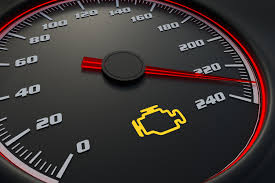Picture this: You’re cruising down the highway, singing along to your favorite song, when suddenly that dreaded amber glow appears on your dashboard. Your heart skips a beat as the check engine light stares back at you like an accusatory eye. If you’re like 70% of drivers according to recent automotive surveys, you’ll spend the next few miles wondering if your car is about to explode or if you can safely ignore it until your next oil change.
The truth is, your check engine light is essentially your car’s way of sending you a text message—and like any good communication, understanding what it’s trying to tell you can save you time, money, and a whole lot of stress.
Decoding the Mystery: What That Light Actually Means
Your check engine light is connected to your vehicle’s onboard diagnostic system, specifically the OBD-II (On-Board Diagnostics II) port that’s been standard in cars since 1996. Think of it as your car’s built-in doctor that constantly monitors various systems and components. When something goes awry, it stores a diagnostic trouble code and illuminates that amber warning light.
Understanding check engine light meanings starts with recognizing that this single light can indicate hundreds of different issues—from something as simple as a loose gas cap to more complex problems involving your engine’s core systems. The light itself doesn’t tell you exactly what’s wrong; it’s more like a gentle tap on the shoulder saying, “Hey, we need to talk.”
The Panic Scale: When to Take Action Immediately
Not all check engine light situations are created equal. Here’s how to gauge your response:
Code Red: Stop Driving Now
If your check engine light is flashing or blinking, this is your car’s equivalent of screaming. A flashing light typically indicates a misfire that could damage your catalytic converter—an expensive component that can cost upwards of $2,000 to replace. Pull over safely and call for assistance.
Code Yellow: Schedule Service Soon
A steady, solid check engine light means your car has detected an issue but it’s not immediately catastrophic. You can typically continue driving, but you should schedule a diagnostic appointment within a week or two. Ignoring it longer could turn a minor issue into a major expense.
Code Green: Monitor and Investigate
Some intermittent check engine lights that come and go might be triggered by temporary conditions. However, even these deserve attention since they often indicate the early stages of developing problems.
Common Culprits: What’s Usually Behind the Light
Engine diagnostics reveal that certain issues trigger check engine lights more frequently than others. Here are the most common offenders:
Oxygen sensor failure accounts for nearly 20% of all check engine light activations. These sensors monitor your exhaust system and help optimize fuel efficiency. A faulty oxygen sensor won’t leave you stranded, but it can reduce your gas mileage by up to 40%.
Catalytic converter problems often develop gradually and may be prevented with proper maintenance. These issues typically manifest as reduced acceleration and poor fuel economy before the light appears.
Mass airflow sensor issues can cause rough idling, difficulty starting, and decreased performance. Fortunately, this is often resolved with a thorough cleaning rather than replacement.
Spark plug and ignition coil problems are particularly common in high-mileage vehicles. These components are part of regular preventative maintenance schedules, and replacing them proactively can prevent check engine light episodes.
Loose or damaged gas caps might seem trivial, but they’re responsible for about 10% of check engine light activations. The fuel system is sealed for emissions control, and even a slightly loose cap can trigger the warning.
The Diagnostic Process: What Happens Next
When you take your vehicle to a qualified technician, they’ll connect a diagnostic scanner to your car’s OBD-II port to retrieve the stored trouble codes. These alphanumeric codes (like P0171 or P0420) provide specific information about what system triggered the warning.
However, understanding check engine light meanings goes beyond just reading codes. A skilled technician will interpret these codes within the context of your vehicle’s symptoms, maintenance history, and current condition. Sometimes multiple codes appear together, creating a diagnostic puzzle that requires experience to solve correctly.
Professional automotive service centers use specialized equipment and databases to cross-reference codes with known issues, technical service bulletins, and manufacturer recommendations. This comprehensive approach ensures accurate diagnosis and prevents unnecessary repairs.
Prevention: Your Best Defense Strategy
The most effective way to deal with check engine lights is to prevent them from appearing in the first place. Regular preventative maintenance plays a crucial role in keeping your vehicle’s systems healthy and reducing the likelihood of unexpected warnings.
Follow your manufacturer’s recommended maintenance schedule for oil changes, air filter replacements, and spark plug service. These routine services address many of the common issues that trigger check engine lights before they become problems.
Pay attention to your vehicle’s performance between service intervals. Changes in fuel economy, rough idling, unusual noises, or decreased acceleration often precede check engine light activations. Addressing these symptoms early can prevent more extensive damage.
Keep your fuel system clean by occasionally using quality fuel system cleaners and always purchasing gasoline from reputable stations. Contaminated fuel can cause sensor problems and trigger diagnostic codes.
Taking Action: Your Next Steps
When your check engine light appears, resist the urge to either panic or ignore it completely. Instead, note any changes in your vehicle’s performance, check that your gas cap is properly tightened, and schedule a diagnostic appointment with a qualified technician.
Remember that modern vehicles are sophisticated machines with complex interconnected systems. What seems like a simple warning light often provides valuable insight into your car’s overall health. By taking check engine lights seriously and addressing them promptly, you’re not just fixing a current problem—you’re investing in your vehicle’s longevity and your own peace of mind.
The next time that amber light appears on your dashboard, you’ll know exactly what to do. Your car is trying to communicate with you, and now you’re equipped to listen.





























